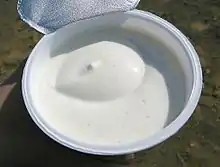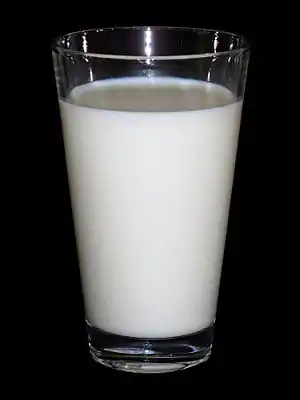Skyr
Skyr[lower-alpha 1] is an Icelandic cultured dairy product. It has the consistency of Greek yogurt, but a milder flavor. Skyr can be classified as a fresh sour milk cheese (similar to curd cheese eaten in Germany and Russia) but is consumed like a yogurt.[1] It has been a part of Icelandic cuisine for centuries.[2]



Skyr has a slightly sour dairy flavor, with a hint of residual sweetness. It is traditionally served cold with milk and a topping of sugar. Commercial manufacturers of skyr have added flavors such as vanilla or fruit.[3]
History
Skyr is mentioned in a number of medieval Icelandic sources, including Egil's saga and Grettis saga. It is unclear how similar this was to modern-day skyr, as no detailed descriptions of skyr exist from this period. Culinary historian Hallgerður Gísladóttir has suggested that skyr was known throughout Scandinavia at the time of the settlement of Iceland, but eventually forgotten outside of Iceland.[4]
The word skyr is related to the English word shear (to cut), referring to how the dairy is split into the liquid whey and the thick skyr.[5]
Nutrition
Skyr is a high-protein, low-fat product made from low-fat milk, varying slightly between brands. Unflavored skyr has roughly 13 g protein, 4 g carbohydrates, and 0.2 g fat (per 100 g).[6]
Uses
Skyr is usually mixed with sugar and milk. A traditional Icelandic dish exists which consists of roughly equal amounts of skyr and porridge. Skyr is often mixed with jam or fruit for a dessert, with prepared fish for dinner, or with cereals for breakfast. Contemporary uses include using skyr as a cheesecake topping and as an ingredient in milkshake or fruit smoothies.
Production
Skyr is made from skimmed milk which has been brought close to a boiling point and then cooled down to 37 °C (99 °F).[7] A small portion of a previous batch of skyr is then added to the warm milk to introduce the essential culture (the active bacterial culture), and with the addition of rennet the milk starts to curdle.[7] It is left to ferment for 5 hours before being cooled down to 18 °C (64 °F).[7] After pasteurization the dairy is strained through fabric to remove the liquid whey.[7][2]
Bacteria such as Streptococcus thermophilus and Lactobacillus delbrueckii subsp. bulgaricus play an important role in the fermentation of skyr.[7] They also play a major role in the production of yogurt, but the yeast which is active in the low temperature step ensures that the dairy becomes a skyr and not a yogurt.[7]
Popularity
Skyr is commonly consumed in Iceland.[8] Efforts at marketing it outside of Iceland began in 2005 when it started being exported to the U.S. and sold at Whole Foods.[9][10] Licensed production began the next year in Denmark and Scotland.[9] Mjólkursamsalan (the major dairy cooperative in Iceland) and its associates registered "skyr" as a trademark in some countries, but this was later ruled to be invalid as skyr was found to be a generic term like "milk".[11][12]
Skyr's popularity outside of Iceland rapidly increased in the 2010s, with it being marketed as a low-sugar, no-fat, high-protein product that could be eaten on the go.[13] In 2012, 80% of exported Icelandic skyr went to Finland and 20% to the US.[14] 25 skyr parlors were opened in Finland in 2019.[15]
See also
Notes
- English pronunciation: /ˈskɪər/ SKEER; Icelandic pronunciation: [ˈscɪːr̥]
References
- Guðmundur Guðmundsson (23 February 2007). "Hnigfræði og smásæ bygging skyrs: Abstract" (in Icelandic and English). Archived from the original on 10 July 2012. Retrieved 25 April 2012.
- "About the production of skyr" (in Icelandic). Mjólkursamsalan. 6 February 2005. Archived from the original on 6 February 2005.
- Severson, Kim (14 September 2005). "Iceland woos America with lamb and skyr". New York Times. Retrieved 25 June 2018.
- Hallgerður Gísladóttir (1999). Íslensk matarhefð (in Icelandic). Reykjavík: Mál og menning. p. 73. ISBN 978-9979-3-1846-0.
- Ásgeir Blöndal Magnússon (1989). Icelandic Etymological Dictionary (in Icelandic). ISBN 9789979654018.
- "Nutritional values for KEA skyr hrært". Mjólkursamsalan (in Icelandic). Retrieved 26 February 2019.
- Björn Sigurður Gunnarsson (11 April 2003). "Hvernig er skyrgerillinn til kominn?". Vísindavefurinn (in Icelandic). Retrieved 26 February 2019.
- "Icelandic skyr now makes up 2% of the US yogurt market". Icelandmag. Fréttablaðið. 23 March 2017. Retrieved 26 February 2019.
- "Ársskýrla Auðhumlu 2006" (PDF). 2006. p. 13.
- "Sigurför skyrsins". Morgunblaðið. 26 August 2005. p. 8.
- "MS missir spón úr aski sínum: Skyr er vörutegund en ekki vörumerki". Stundin. Retrieved 14 January 2021.
- "Arla lagði MS í deilu um skyr í Finnlandi". RÚV (in Icelandic). 28 September 2017. Retrieved 14 January 2021.
- "Welcome to skyr, the Viking 'superfood' waking up Britain". the Guardian. 27 November 2016. Retrieved 14 January 2021.
- "Skyr selt erlendis fyrir 650 milljónir - Viðskiptablaðið". www.vb.is. Retrieved 14 January 2021.
- "Finnar óðir í ísey skyr: 25 barir opnaðir í landinu". hringbraut.frettabladid.is. Retrieved 14 January 2021.
| Wikimedia Commons has media related to Skyr. |

